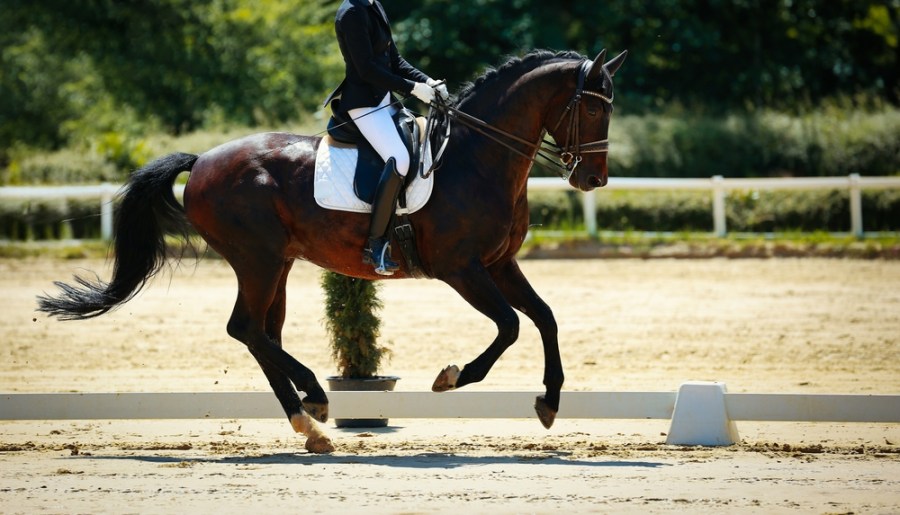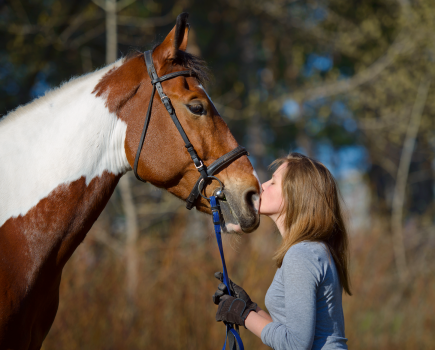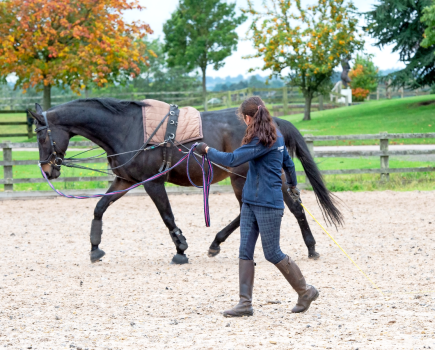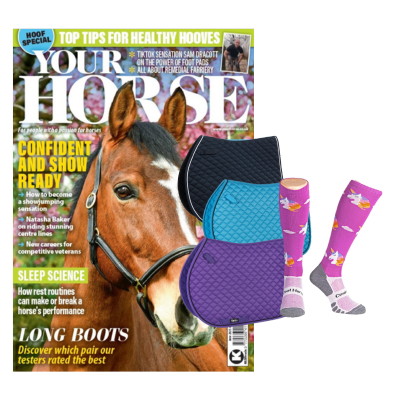We use a system of aids to communicate with our horses with the aim that our aids will be barely visible to the observer — and this includes half halts.
The natural aids are seat, leg and rein aids. Let’s think of them as words we speak silently to our horse. When we combine our aids in a sequence we might think of these as words forming a simple sentence.
A half halt is perhaps the breathing space between the words or even the sentences themselves.
It is a way of rebalancing; a tiny moment of pause where we are preparing for the next movement or decision or response; a signal to the horse that the conversation is becoming more nuanced.
In this article I’m going to talk about what’s going on when you half halt, how you might experience the feeling of influencing your horse’s way of going, and where to start if you and your horse haven’t thought about half halts yet.
The aim of a half halt
Half halts might seem like the domain of the dressage horse, but whatever your preferred discipline — whether you are riding in an an arena or hacking out — being able to ride in a safe and balanced way is important.
This stems from how you communicate with your horse using a system of clear, consistent aids to guide and support them.
The FEI states that the aim of half halt is to “increase attention, improve balance and collection of the horse”.
There is a longer explanation and lots of really useful insights from riders and trainers, so it’s possible to take an in depth look at the subject.
So much information can be overwhelming, however, and I will give you some exercises and explanations you might find useful on this page.
When they’re used
A half halt can encourage a horse to shift their balance, transferring the weight they would naturally carry on their forehand backwards, so that they begin to use their hind quarters to support their weight.
Over time and with correct training, this will develop the horse’s ability to work in collection as they achieve the scales of training.
It’s important to say here that it takes many years to train a horse to be physically and mentally prepared to work at an advanced level.
The half halt is going to be an important part of your communication system at every level.
Whenever we ask our horse to do things as simple as:
- Change pace or tempo
- Adjust their stride
- Prepare to do something such as changing the rein
- Arrive at a junction to cross the road
- Ride in between fences in good rhythm and balance
The list is endless and often we are already using a form of halt halt without realising it.
Rider’s seat aids
So let’s break it down into how the aids work together when you ask for a half halt.
First your posture and how you sit in the saddle are going to have a role in developing and maintaining rhythm and balance.
Where you look and how you breathe will also have an impact on how you communicate with your seat aids.
For example, think about how you follow your horse with your seat when riding up and downhill.
When you want to stay in balance with your horse in a trot-canter transition, it can be helpful to think about riding uphill.
This can help you find and maintain your balance so that you follow your horse’s movement.
Developing an independent seat is important too, as you need to learn not to use the reins to support you.
Hanging on tightly to the reins or pulling back without meaning to is like inadvertently applying a brake to a car and wondering why things feel erratic.
Once we have a supple and balanced seat we can use our reins to communicate with our horses.
The aim here is to develop an elastic contact so that we can again follow the horses’s movement and encourage them to seek a contact with the rein.
Leg aids
There are sequences of leg aids to learn and become familiar with.
It’s worth thinking in terms of, “what is my leg asking the horse?”
When you put your inside leg on you are asking your horse to step forward with their hind leg.
With training, you will be able to influence the activity from the hind legs to develop impulsion, straightness and (later) collection.
Think of the half halt as being an ‘advance request’.
You are activating your horse with your leg asking them to go forwards.
Your hand receives this new energy and so does your horse, who in that moment needs a decision and further instructions from you.
You receive the energy and close your fingers around the rein.
As the half halt is a rebalancing request, you then allow your hand to follow the horse’s movement.
By half halting they have taken more weight on their hind quarters and lightened the forehand.
Space to breathe
“Every half halt implies the need for greater animation”
This phrase in a book by Erik Herbermann really resonated with me.
Egon von Neindorff also said: “Drive. Receive (sustain or ‘take up’ the energy) — become lighter again.”
When I read this, it speaks of the lightness of movement and a sense of space to soften and breathe, to feel a moment of suspension in between the power and later cadence of the trot.
There is an artistry described in his work that transports me to the arena and my enjoyment of finding these shared moments with my horses.
When we then hack out and find these moments again, there is another dimension to experience.
Riding and competing is something I enjoy so much that I find it hard to articulate the feelings of challenge and effort and love for the horses who communicate through movement and emotion.
When I read his words I’m reconnecting with those moments.
With my coaching hat on, I think part of the joy of schooling is to find a way to communicate with each horse we meet.
So as a rider, we can become familiar with the effect of the half halt and the influence it has on our horse’s balance.
How to half halt
Perhaps you haven’t knowingly ridden a half halt yet.
Let’s keep it simple by first trying this pattern and enjoying the feeling of riding your horse.
- Ride a 20m circle in working trot
- Then go large in working trot
- Pick a good moment to go forwards to walk
- Make a change of rein across the diagonal
- Pick up working trot again
- Ride a 20m circle
- Go large and return to walk, before changing the rein and repeating the exercise.
Your priority is to notice the trot rhythm and aim to maintain the same rhythm around the circle and onto the long side.
Next notice what happens in your downwards and upwards transitions.
- Did your horse understand?
- Were you able to keep your balance and remember to breathe as well?
- Did your horse find the exercise easier on one rein than the other?
- Do the transitions flow seamlessly from one pace to the next?
Transitions
After a walk break, ride back onto a circle.
This time, though, ride a transition to walk and then back to trot as you cross the centre line.
Aim for a smooth transition, allow your horse to relax into the walk and then trot on again staying on the circle.
Repeat this pattern with this transition a few times and think about what it feels like.
- Do you have a consistent elastic contact?
- Are you finding it easy to sit tall?
- When you apply your leg aid does your horse respond by stepping forward with their hind leg?
‘Almost-walk’
Next, when you are confident with the exercise on both reins, try an ‘almost-walk’ transition.
Use your leg to active the trot, sit taller, and close your fingers around the reins. However, this time before you walk, open your fingers a little and as you apply your leg to go forwards to trot again, allow your hands to follow the horse.
If you’re not quite following, try thinking of it this way: although you half started a downward transition, you have changed your mind and your hands must allow the horse to trot forwards again as your legs say “let’s repair the trot rhythm”.
Remember this is not about letting go of the reins.
You still need to be keeping the conversation going through the reins and encouraging your horse to be seeking the rein, stretching their neck forward and taking the rein.
Feeling a half-halt
The almost-walk transition is about preparing both horse and rider for the feeling they are seeking in a half halt — that is, a moment to rebalance.
If your horse becomes unsettled or tense change things up. You might find they enjoy a canter or to do a serpentine that allows them to settle into a trot rhythm with the chance to focus on what you are asking.
As with all new exercises, take your time and help your horse understand the exercise.
Be sure to praise them for trying to answer your questions and let them have regular breaks.
We want them to enjoy their schooling sessions!
The ‘non-transition’
A natural progression for the ‘almost-walk’ transition is the ‘non-transition’, which almost shortens the trot stride with a subtle half halt that could become a walk transition.
It’s really about asking for the horse to be a little more balanced in their trot work.
This is where timing plays a part, because as a rider you are asking your horse to ‘sit’ and take their weight back in order to lighten their forehand.
This half halt must not come just from the hand, we are not going to pull the rein or damage the rhythmical flow of the trot by stopping / blocking our horse through the rein.
Be creative with your arena space and include circles, diamonds, squares and straight lines asking for transitions and non transitions in different places.
These schooling figures are going to feel very different when riding horses at varying levels of training.
Half halts too feel different on horses who are further on in their training.
A Grand Prix horse is very powerful and established with a greater degree of collection and balance.
The rider’s job is to be able to ride quietly and effectively, to manage the timing and complexity of the aids in order to communicate with the advanced horse.
Be patient with yourself and your horse as you work on your balance and communication together.
You perform best when you work as a team and this means accepting you will both make mistakes even when you are trying really hard to be consistent.
Whatever your starting point with half halts, whether you and your horse are just beginning or confidently communicating, balance will always be something you work on.
The half halt is your key to unlocking each layer of development.
Main image © Shutterstock








